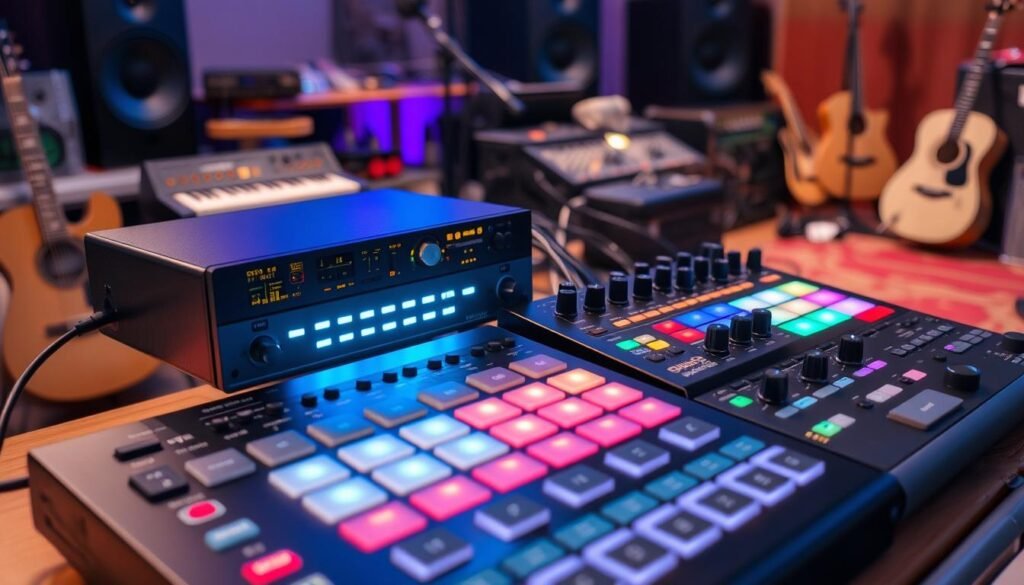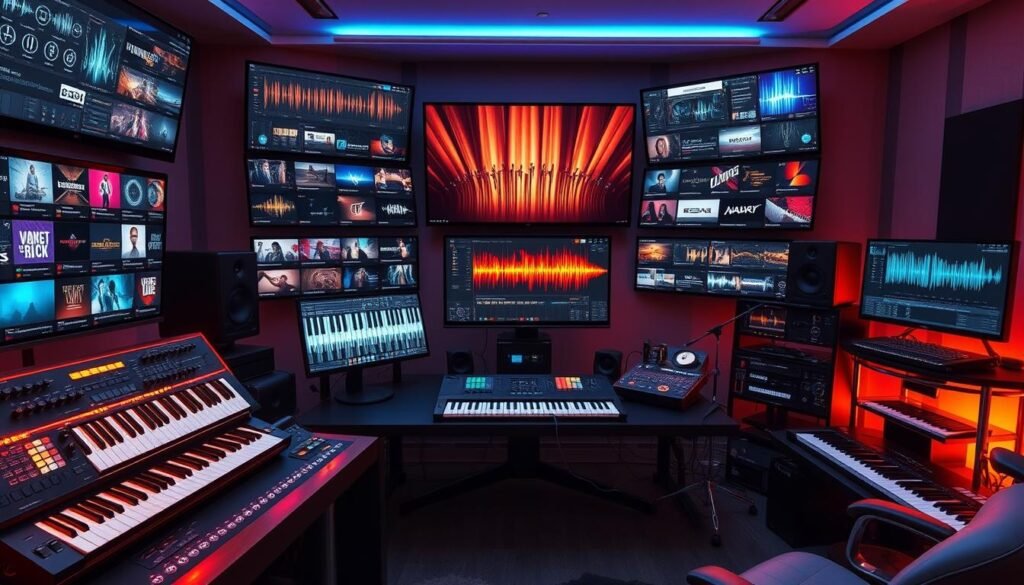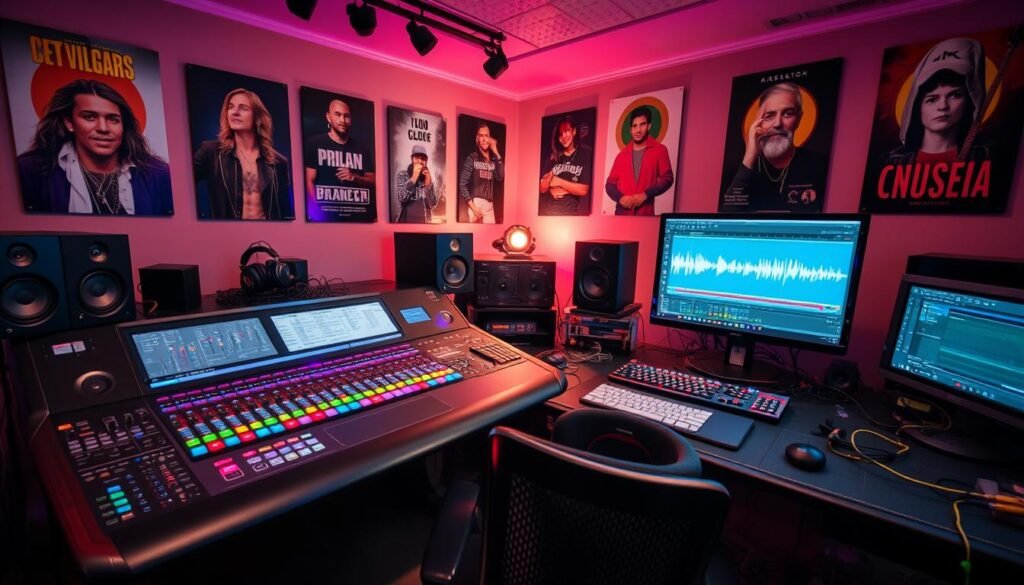
It was a warm summer evening when I first stepped into my makeshift home studio. I had a laptop, headphones, and a dream to create music. As a college student, I had been waiting years to start making music.
I was excited and a bit nervous as I started learning about music production. I dove into sound engineering, virtual instruments, and digital audio workstations. This hobby quickly turned into a full-time passion, with me spending hours honing my skills.
Now, I’m excited to share what I’ve learned. This guide will help you understand the tools and software needed for music production. It’s for both new and experienced producers. You’ll learn how to make your own music, track by track.
Key Takeaways
- Discover the fundamental components of modern music production
- Explore the essential hardware and software for your home studio setup
- Understand the role of digital audio workstations (DAWs) and their key features
- Learn about audio interfaces, MIDI controllers, and recording techniques
- Dive into the world of virtual instruments, sound libraries, and production effects
- Understand the basics of mixing and bringing your tracks together
- Develop strategies for project organization, backup, and collaboration
Understanding the Fundamentals of Music Production
Creating music is a complex process that needs a deep understanding of several key areas. These include sound design, music mixing, and the details of recording studios. Knowing these basics is crucial for both aspiring artists and producers.
Key Components of Modern Music Making
Music production combines sound design, audio engineering, and music mixing. Sound design is about making and changing digital sounds. Music mixing is about combining these sounds to get the right sound quality. Recording studios, with their advanced gear and soundproof rooms, are key for capturing and improving audio.
The Production Process Overview
The music production process has several stages, like songwriting, recording, editing, mixing, and mastering. Each step needs specific skills and methods to make the final product sound great. Knowing this process helps you manage the music-making journey and turn your ideas into music.
Basic Terminology You Need to Know
It’s important to learn the common terms in music production. Words like “DAW” (Digital Audio Workstation), “MIDI” (Musical Instrument Digital Interface), and “plugins” are part of the music world. Understanding these terms helps you communicate and grasp the technical sides of music.
Learning the basics of music production helps you create amazing sounds and bring your ideas to life. Whether you’re experienced or new, knowing these core concepts is a strong base for your music journey.
Essential Hardware for Your Home Studio Setup
Setting up a home music production studio needs more than just a computer. You’ll need to invest in several key hardware components. Let’s look at the essential equipment to take your home studio to the next level.
Audio Interfaces: The Heart of Your Studio
An audio interface connects your instruments, microphones, and computer. It converts analog audio signals into digital data for your DAW. Choose an interface with the right inputs and outputs for your gear and high-quality converters for clear sound.
MIDI Controllers: Expressive Hands-On Control
MIDI controllers, like keyboards and drum pads, offer a hands-on way to interact with your music software. They let you play virtual instruments and control your DAW, enhancing your creative experience.
Monitoring: Accurate Playback and Mixing
Good monitoring is key for making informed mixing decisions. Get high-quality studio monitors and professional headphones for accurate audio assessment. Consider your room’s size and acoustics when choosing monitors.
| Hardware Component | Key Considerations | Recommended Features |
|---|---|---|
| Audio Interfaces | Number of inputs/outputs, audio quality, connectivity | Multiple analog and digital inputs, high-resolution conversion, USB or Thunderbolt connectivity |
| MIDI Controllers | Size, key action, additional control features | Velocity-sensitive keys, programmable knobs and faders, USB or MIDI connectivity |
| Studio Monitors | Size, frequency response, power output | Accurate, balanced sound reproduction, appropriate size for your room, built-in amplification |
Investing in these essential components will help you create a professional music production studio at home. Choose gear that fits your needs and budget for a smooth workflow.
Digital Audio Workstations (DAW): Your Production Hub
A Digital Audio Workstation (DAW) is key to music production. For beginners, choosing a DAW can seem overwhelming. But don’t worry, we’re here to help you understand the basics.
Popular DAW Options for Beginners
Beginners have many DAW choices. For Mac users, Garageband is a free option. Audacity is free and open-source for Windows and Mac. Ableton Live is a paid choice known for its user-friendly interface.
Free vs. Paid DAW Solutions
Choosing between free and paid daw music platforms depends on your budget and needs. Free options like Garageband and Audacity are great for learning the basics. Paid DAWs offer more advanced features and tools for experienced producers.
Key Features to Look for in a DAW
- Intuitive user interface
- Comprehensive audio and MIDI recording capabilities
- Robust editing tools for refining your tracks
- Powerful mixing and mastering features
- Extensive virtual instrument and effects library
- Seamless integration with external hardware
- Collaboration and sharing capabilities
Finding the right daw music solution is crucial. It can help you bring your music to life. By considering your needs and exploring options, you’ll find the perfect DAW for your music production journey.
Getting Started with Audio Interfaces and MIDI Controllers
In the world of electronic music, audio interfaces and MIDI controllers are key. They connect your computer to the world of sound. This lets you capture and shape your ideas with great detail.
Audio interfaces are the heart of your recording setup. They convert sound into digital form and work fast. They have many inputs and outputs, phantom power, and direct monitoring.
MIDI controllers let you control your music software and virtual instruments. They range from simple keyboards to complex devices with many controls. This way, you can play your music live and tweak your mixes with ease.
| Feature | Audio Interface | MIDI Controller |
|---|---|---|
| Purpose | Converts analog audio to digital | Provides physical control over digital audio software |
| Connections | XLR, 1/4″ TRS, RCA | USB, MIDI (DIN) |
| Key Functions | Microphone preamps, phantom power, AD/DA conversion | Keyboard, pads, knobs, faders, buttons |
When picking your audio interface and MIDI controller, think about what you need. Look at the number of inputs, the quality, and how well they work with your DAW. Good hardware can greatly improve your music-making process and sound quality.

Microphones and Recording Techniques for Better Sound
Getting high-quality audio is key for any music project. This is true whether you’re in a pro studio or a home sound design space. Knowing about microphones and basic recording techniques can really boost your audio quality.
Different Types of Microphones
There are many kinds of microphones, each with its own strengths and uses. Here are a few common ones:
- Condenser microphones: These are super sensitive and great for catching fine details. They’re perfect for vocals, acoustic instruments, and studio work.
- Dynamic microphones: These are tough and versatile. They’re good for live shows, loud sounds, and recording drums or amps.
- Ribbon microphones: Known for their warm sound, they’re often used for vocals, guitar amps, and brass.
Basic Recording Patterns
How you place your microphone affects the sound a lot. Here are some common patterns:
- Cardioid: This pattern focuses on sound from the front, ignoring sides and back. It’s great for vocals and solo instruments.
- Omnidirectional: This picks up sound from all directions, creating a natural feel. It’s good for group recordings or room sounds.
- Figure-8: This pattern captures sound from the front and back, ignoring sides. It’s useful for recording duets or creating stereo effects.
Room Acoustics and Setup
The room where you record greatly affects the sound quality. Good room acoustics and setup are crucial. Think about room size, wall materials, furniture, and acoustic treatment to improve your recording studios or sound design space.
| Microphone Type | Recommended Applications |
|---|---|
| Condenser | Vocals, acoustic instruments, studio recordings |
| Dynamic | Live performances, loud sources, drums, amplified instruments |
| Ribbon | Vocals, guitar amps, brass instruments |
Knowing about microphones, recording patterns, and room acoustics helps you make pro-sounding recordings. This improves your music production projects in your recording studios or sound design space.
Virtual Instruments and Sound Libraries
Welcome to the world of virtual instruments and sound libraries. These digital tools are key for modern music production. They offer a wide range of creative options, from guitar tones to drum kits, all at your fingertips.
Virtual instruments have changed music-making. They add new life to your songs, whether you’re experienced or just starting. Explore the vast world of virtual instruments. You’ll find many guitar options, free drum kits, and more.
Discover the Power of Virtual Guitars
Guitars are a big part of music, and virtual guitars take it to the next level. You can find many guitar virtual options. They let you add the warm tones of guitars to your music, from rock to finger-picking.
Unleash Your Rhythm with Free Drum Kits
Boost your tracks with free drum kits. These virtual drums offer a wide range of sounds, from deep kicks to sharp cymbals. Try out different styles and make beats that grab your listeners.
Exploring virtual instruments and sound libraries opens up new creative doors. These digital tools offer flexibility, realism, and ease. Let your music vision grow and reach new heights.
| Virtual Instrument | Description | Price |
|---|---|---|
| Addictive Drums 2 | Highly realistic drum samples and customizable kits | $199 |
| Native Instruments Kontakt | Powerful sampling and sound engine with a vast library | $399 |
| Spitfire Audio LABS | Free collection of high-quality virtual instruments | Free |

“Virtual instruments have opened up a world of creative possibilities for musicians and producers alike. They’ve revolutionized the way we approach music-making, allowing us to explore new sonic territories and push the boundaries of our craft.”
Understanding Music Production Effects and Plugins
In music production, audio effects and plugins are key. They shape your tracks’ sound and character. From small tweaks to big changes, these tools can make your music stand out. Let’s look at the main audio effects, essential plugin types, and the differences between free and paid options.
Essential Audio Effects
Music producers have many audio effects to choose from. Some top ones are:
- Reverb: Adds depth and ambiance, making your sound feel like it’s in different spaces.
- Delay: Creates echoes and rhythmic delays, adding depth and texture.
- Compression: Levels out your audio, making it sound more consistent and punchy.
- Equalization (EQ): Lets you shape the sound by boosting or cutting specific frequencies.
- Distortion: Adds grit and warmth to your instruments and vocals.
Must-Have Plugin Categories
There are many plugin categories every producer needs:
- Virtual Instruments: Mimics a wide range of instruments, from synthesizers to drums.
- Sound Design Tools: Allows for advanced sound shaping, creating unique textures.
- Mixing and Mastering Plugins: Offers tools for balancing and enhancing your final mix.
Free vs Premium Plugin Options
When building your plugin collection, you’ll find free and paid options. Free plugins are great for starting out, offering many effects and instruments. But, premium plugins have more advanced features and better sound quality. Your choice will depend on your needs, budget, and how much control you want over your audio plugins and sound design.
| Feature | Free Plugins | Premium Plugins |
|---|---|---|
| Sound Quality | Varying quality, often lower-resolution | Higher-quality, professional-grade sound |
| Feature Set | Limited functionality, fewer options | Extensive features, advanced controls |
| Stability and Support | Can be less reliable, with occasional bugs | Robust stability, reliable performance, and ongoing updates |
| Workflow Integration | May not integrate seamlessly with your DAW | Designed for optimal integration with your production environment |
Exploring both free and premium plugins can help you find the best tools for your music production journey.
Mixing Basics: Bringing Your Tracks Together
Music mixing is key in audio engineering. It’s where you fine-tune and balance your tracks for a polished sound. This guide will teach you the basics to elevate your music production.
Mixing aims to create a clear, balanced sound. You’ll adjust each track’s volume, called gain staging. This ensures no sound is too loud or too quiet. You’ll also learn to use equalization (EQ) to shape the sound of each track, making it clearer and more defined.
Compression is another vital tool in mixing. It helps even out the loud and quiet parts of your tracks. By using compression wisely, your mix will sound more cohesive and powerful.
You’ll also discover how to pan your tracks. Panning spreads the sound across the stereo field, making it wider and more immersive. Proper panning helps separate sounds, adding depth and interest to your mix.
Music mixing is an art that requires practice and creativity. By mastering these basic techniques, you’ll be on your way to creating standout mixes.

“The art of mixing is to create a beautiful, balanced landscape where every element has its place and contributes to the overall picture.” – Renowned audio engineer
Keep honing your audio engineering skills. You’ll be amazed at the professional mixes you can create.
Introduction to Music Production Software Workflows
Learning from famous music producers can boost your music-making skills. They share shortcuts and new ways to make music. This can make your music-making journey more efficient and creative.
Famous music producers use specific music software tools to work better. They use these tools to save time, automate tasks, and explore new sounds. Knowing their software choices can help you set up your music production for better results.
- Understand the Importance of Workflow Optimization: Good music production workflows save time and energy. This lets you focus more on being creative.
- Explore the Workflows of Successful Producers: Look at how famous music producers work. This can give you ideas for your own creative process and software use.
- Customize Your Music Software Setup: Make your music software fit your unique style and vision. This makes your music-making more personal and effective.
- Implement Time-Saving Shortcuts and Automation: Find shortcuts and automation tools in your music software. These can make repetitive tasks easier and faster.
- Experiment with Novel Production Approaches: Try new techniques and software. This can lead to new and exciting sounds in your music.
By following the workflows of top music producers, you can improve your music software skills. This can make your music-making more efficient and creative.
| Famous Music Producer | Preferred Music Software | Signature Production Techniques |
|---|---|---|
| Quincy Jones | Pro Tools, Logic Pro | Extensive use of sampling, layering, and sound design |
| Timbaland | FL Studio, Pro Tools | Innovative rhythmic programming, experimental sound choices |
| Max Martin | Cubase, Pro Tools | Meticulous attention to song structure and pop production elements |
“The right tools can make all the difference in the creative process. Mastering your music software workflow is key to unlocking your full potential as a producer.”
Best Practices for Project Organization and Backup
As a music producer, organizing your projects and having good backup plans are key. They make your work flow smoothly and efficiently. Let’s look at some top tips to make your music production easier.
File Management Strategies
Having a good file management system is vital. Use a consistent naming system for your files and folders. This makes it easy to find and use your work when you need it.
Also, keep your folders organized. Use different folders for your projects, samples, and other important files. This helps you access what you need quickly.
Backup Solutions for Musicians
It’s crucial to protect your music. Use a solid backup plan to keep your work safe. You can use cloud storage, external hard drives, or both.
Make it a habit to back up your files regularly. This includes your project files, audio samples, and other key data. It gives you peace of mind and keeps your music safe.
Collaboration Tools and Methods
Collaboration is key in today’s music world. Look into tools and methods that make working with others easy. Cloud-based platforms, version control systems, and midi to sheet music tools can help a lot.
By following these tips, you’ll be able to organize your projects, keep your work safe, and work well with others. A well-organized and backed-up workflow boosts your creativity and helps bring your musical ideas to life.
| File Management Strategies | Backup Solutions for Musicians | Collaboration Tools and Methods |
|---|---|---|
|
|
|
Conclusion
As you’ve learned about music production, you’ve gained key insights. You now know how to set up your home studio and mix music. This journey is all about learning and trying new things.
This guide has given you a strong start. But the real fun is in using what you’ve learned. By improving your music production skills, you can create sounds that amaze people. This will make your music stand out.
Don’t stop exploring and trying new things. The music world is always changing. With hard work and a love for learning, you’ll keep getting better. You’ll make music that touches people’s hearts and leaves a lasting impact.